6 releases (stable)
| 1.1.1 | Aug 11, 2023 |
|---|---|
| 1.1.0 | Jul 26, 2023 |
| 0.1.1 | Oct 5, 2022 |
#588 in GUI
38 downloads per month
88KB
2K
SLoC
tui-markup-renderer
Rust library to use TUI and markup to build UI terminal interfaces.
tl;dr;
You can use the tool to generate a new project:
# Install the package
cargo install tui-markup-renderer
# this will show you some help messages
tui-markup-gen -h
# To create a simple project called dummy_project use the next line:
tui-markup-gen -n dummy_name -t simple
# To create a shell project called complex_project use the next line:
tui-markup-gen -n complex_name -t shell
Xml Code:
<layout id="root" direction="vertical">
<block constraint="10"> <!-- Don't forget the size, 1 by default -->
<p align="center">
Press q to quit.
</p>
</block>
<block id="bts_block" constraint="6">
<button id="btn_hello" action="open_dialog" index="1"> Say Hello </button>
</block>
<dialog id="dlg" show="show_dialog" buttons="Okay" action="on_dialog_event">
<block id="dlg_block" border="all">
<p align="center">
Hello World!!!
</p>
</block>
</dialog>
</layout>
Rust Code:
use crossterm::event::KeyCode::{self, Char};
use std::{collections::HashMap, io};
use tui::backend::CrosstermBackend;
use tui_markup_renderer::{event_response::EventResponse, markup_parser::MarkupParser};
fn main() -> Result<(), Box<dyn std::error::Error>> {
// get access to StdOut
let stdout = io::stdout();
// Get the backend for TUI
let backend = CrosstermBackend::new(stdout);
// prepare the internal state for the app info
let state = Some(HashMap::new());
// prepare the markup parser
let mut mp = MarkupParser::new("./assets/layout.tml".to_string(), None, state);
// Dialogs generate button identifiers following the convention "on_<dialog id>_btn_<button name>"
mp.add_action("open_dialog", |state| {
let mut state = state.clone();
state.insert("show_dialog".to_string(), "true".to_string());
EventResponse::STATE(state)
})
.add_action("on_dlg_btn_Okay", |state| {
let mut state = state.clone();
state.insert("show_dialog".to_string(), "false".to_string());
EventResponse::STATE(state)
})
.ui_loop(backend, |key_event, mut state| {
let mut pressed = "none";
match key_event.code {
KeyCode::Esc => {
pressed = "close_dialog";
}
Char('q') => {
pressed = "close";
}
_ => {}
}
match pressed {
"close_dialog" => {
state.insert("show_dialog".to_string(), "false".to_string());
EventResponse::STATE(state)
}
"close" => {
state.insert("show_dialog".to_string(), "false".to_string());
EventResponse::QUIT
}
_ => EventResponse::NOOP,
}
})
}
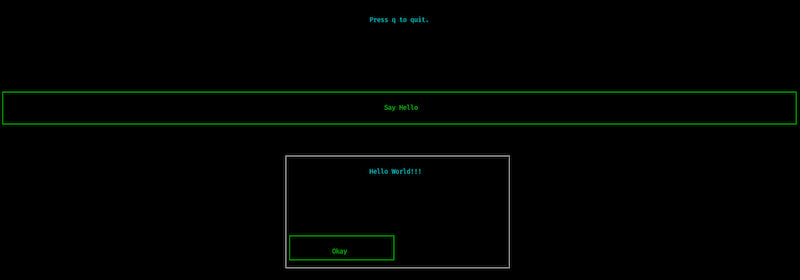
Explanation
How it works
As a developer is easier to create a known data structure describing the user interface.
Sample markup code:
<layout id="root" direction="vertical">
<container id="nav_container" constraint="5">
<p id="toolbar" title="Navigation" border="all" styles="fg:green">
This is the navigation
</p>
</container>
<container id="body_container" constraint="10min">
<p id="body" title="Body" border="all" styles="fg:red">
This is a sample
</p>
</container>
</layout>
generates:
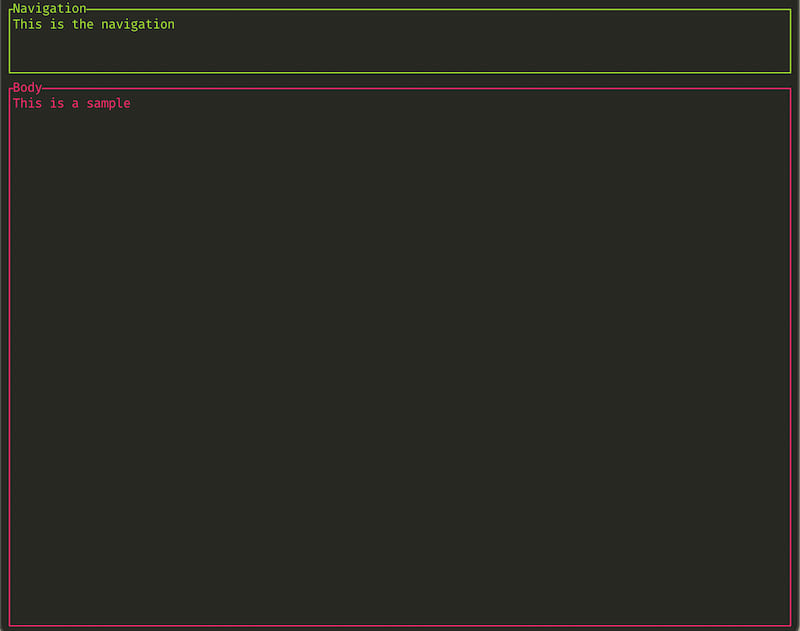
A more complex sample:
<layout id="root" direction="vertical">
<container id="nav_container" constraint="5">
<p id="toolbar" title="Actions" border="all" styles="fg:green">
This is a sample
</p>
</container>
<container id="body_container" constraint="10min">
<block id="body_block" border="none">
<layout id="content_info" direction="horizontal">
<container id="ats_container" constraint="20%">
<block id="ats_block" title="Ats" border="all">
</block>
</container>
<container id="cnt_container" constraint="20min">
<block id="cnt_block" title="Cnt" border="all">
</block>
</container>
</layout>
</block>
</container>
<container id="nav_container" constraint="5">
<p id="footer" border="all" styles="bg:red;fg:black">
This is a sample
</p>
</container>
</layout>
generates:

Planned features
- Add documentation to use it.
- Runtime template change.
The Rules!
- A layout allow dev to define the direction flow.
- A block is a panel that can have:
- borders
- title
- constarint to define size of the element.
- A block can be parent of a layout.
- A container is a alias of a block.
- A layout should contains blocks/containers as children in order to set user interfaces. However, the root layout cound have some elements (like dialogs).
- Every element can have an identifier (id), but the identifiers mut be uniques.
- You can create global styles using the styles tag or the styles property for elements.
- The styles cover (for now):
- bg (background color).
- fg (foreground color).
- weight (font weight).
- You can have a UI state to store UI information.
A Sample
Layout code:
Something better?
<layout id="root" direction="vertical">
<styles>
button {
fg: red;
bg: black;
}
button:focus {
fg: white;
bg: red;
}
#footer {
bg:black;
fg:blue;
}
</styles>
<container id="nav_container" constraint="5">
<p id="toolbar" title="Actions" border="all" styles="fg:green">
Header sample
</p>
</container>
<container id="body_container" constraint="10min">
<block id="body_block" border="none">
<layout id="content_info" direction="horizontal">
<container id="ats_container" constraint="20%" title="Ats" border="all">
<layout id="vert_info" direction="vertical">
<block id="ats_block" constraint="5">
<button id="btn_hello" action="do_something" index="1" styles="fg:magenta" focus_styles="fg:white;bg:magenta"> Hello </button>
</block>
<block id="bts_block" constraint="5">
<button id="btn_hello_2" action="do_something_else" index="3"> Simple </button>
</block>
<block id="bts_block" constraint="5">
<button id="btn_hello_3" action="do_something_else" index="2"> World </button>
</block>
</layout>
</container>
<container id="cnt_container" constraint="20min">
<block id="cnt_block" title="Cnt" border="all">
<p>
lorem ipsum dolor sit amet sample.
</p>
</block>
</container>
</layout>
</block>
</container>
<container id="nav_container" constraint="5">
<p id="footer" border="all">
Footer sample
</p>
</container>
<dialog id="dlg1" show="showQuitDialog" buttons="Yes|Cancel" action="on_dialog_event">
<layout direction="vertical">
<container constraint="3">
<p align="center" styles="weight:bold">
Close Application
</p>
</container>
<container>
<p align="center">
Do you want to close the application?
</p>
</container>
</layout>
</dialog>
</layout>
Rust Code:
use clap::Parser;
use crossterm::event::KeyCode::{Char, self};
use std::{collections::HashMap, io};
use tui::backend::CrosstermBackend;
use tui_markup_renderer::{
markup_parser::MarkupParser,
event_response::EventResponse,
};
#[derive(Parser, Debug)]
#[command(author, version, about, long_about = None)]
struct Args {
#[arg(short, long, default_value_t = String::from("run"))]
execution_type: String,
#[arg(short, long, default_value_t = String::from("./assets/layout1.tml"))]
layout: String,
#[arg(short, long, default_value_t = false)]
print_args: bool,
}
fn main() -> Result<(), Box<dyn std::error::Error>> {
let Args {
layout,
execution_type,
print_args,
} = Args::parse();
let stdout = io::stdout();
let backend = CrosstermBackend::new(stdout);
let state = Some(HashMap::new());
let mut mp = MarkupParser::new(layout.clone(), None, state);
mp.add_action(
"do_something",
|_state: &mut HashMap<String, String>| {
println!("hello!!!");
EventResponse::NOOP
},
)
.add_action(
"do_something_else",
|_state: &mut HashMap<String, String>| {
println!("world!!!");
EventResponse::NOOP
},
)
.add_action(
"on_dlg1_btn_Yes",
|_state: &mut HashMap<String, String>| {
EventResponse::QUIT
},
)
.add_action(
"on_dlg1_btn_Cancel",
|state: &mut HashMap<String, String>| {
let key = "showQuitDialog".to_string();
state.insert(key, "false".to_string());
EventResponse::STATE(state.clone())
},
)
;
if print_args {
println!(
"[layout: {}, execution_type: {}, print_args: {}]",
layout, execution_type, print_args
);
}
if execution_type == String::from("run") {
// async move
mp.ui_loop(backend, |key_event, state| {
let mut new_state = state.clone();
let key = "showQuitDialog".to_string();
// let back_value = String::new();
let mut pressed = '\n';
match key_event.code {
KeyCode::Esc => {
pressed = '\r';
}
Char(character) => {
pressed = character;
}
_ => {}
}
if pressed == '\r' {
let new_value = "false";
new_state.insert(
key,
new_value.to_string(),
);
return EventResponse::STATE(new_state);
}
if pressed == 'q' {
let new_value = "true";
new_state.insert(
key,
new_value.to_string(),
);
return EventResponse::STATE(new_state);
}
return EventResponse::NOOP;
})
} else {
env_logger::init();
mp.test_check(backend)
}
}
Will generate this:
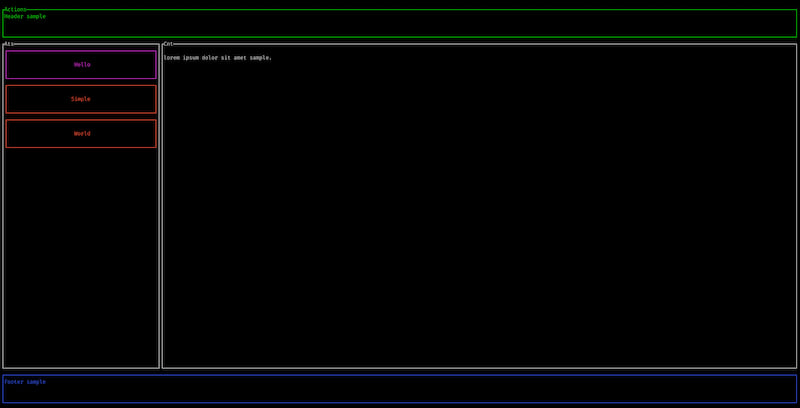
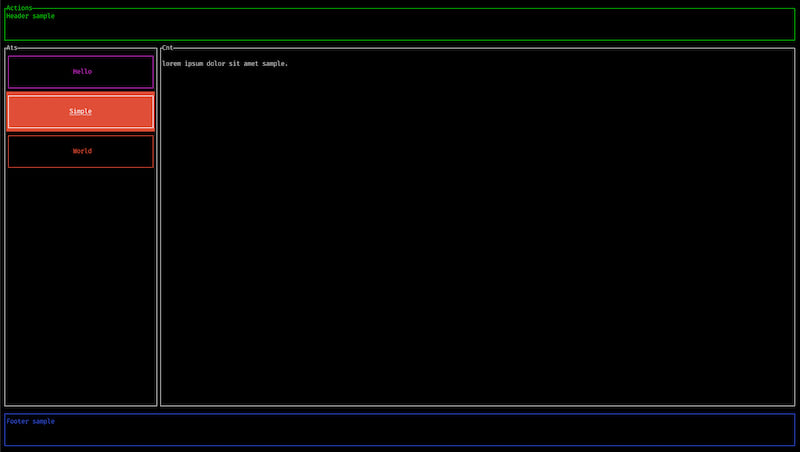
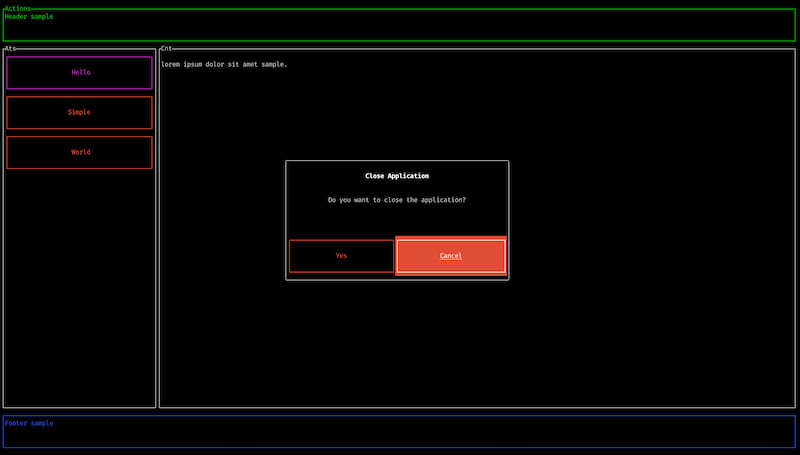
Dependencies
~8–21MB
~221K SLoC